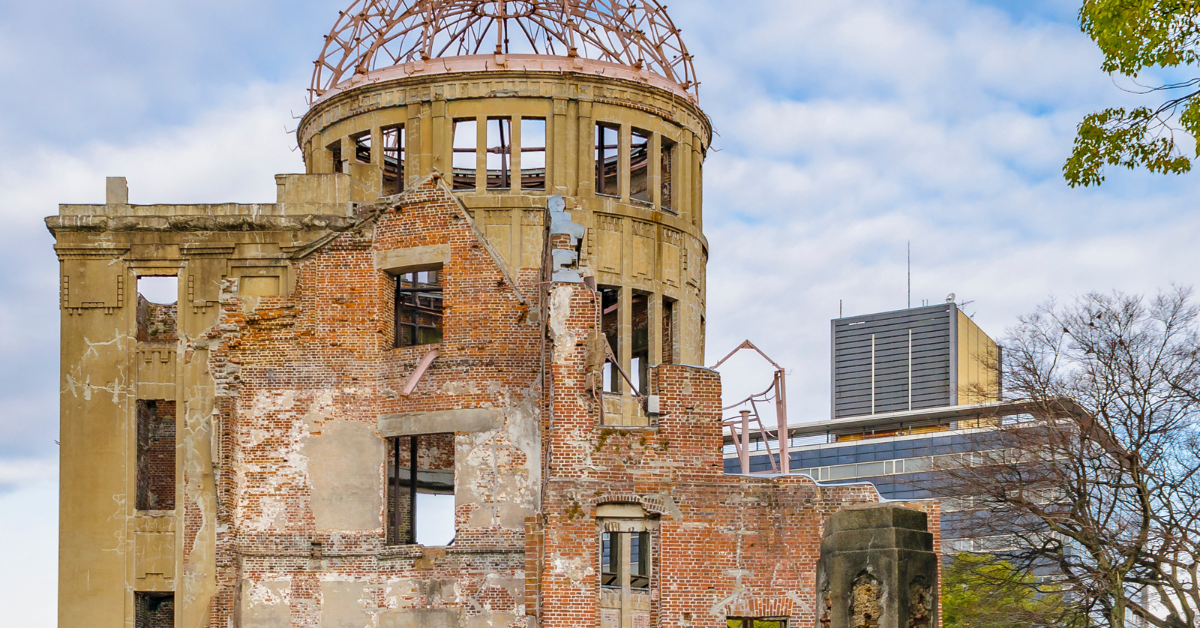The Hiroshima Peace Memorial Museum and the Atomic Bomb Dome are two of the most powerful reminders of the devastation caused by nuclear warfare. Located at the epicenter of the 1945 atomic bombing, these landmarks serve not only as historical evidence but also as symbols of peace and hope. Visitors from around the world come here to learn, reflect, and connect emotionally with Hiroshima’s message: “Never Again.”
HIROSHIMA PEACE MEMORIAL MUSEUM AND ATOMIC BOMB DOME: BASIC INFORMATION
Getting There and Location
The Hiroshima Peace Memorial Museum and Atomic Bomb Dome are located in Peace Memorial Park in central Hiroshima City. Convenient public transportation makes them highly accessible for tourists.
| Departure Point | Travel Time | Mode of Transport |
|---|---|---|
| JR Hiroshima Station | Approx. 15 minutes | Streetcar (Line 1), get off at “Genbaku Dome-mae” |
| Hiroshima Airport | Approx. 60 minutes | Airport limousine bus + streetcar |
| Miyajima-guchi | Approx. 60 minutes | JR line + streetcar |
Tourist information centers and multilingual signs near the park make it easy for first-time visitors to navigate the area.
Opening Hours and Admission Fees
The museum is open year-round and welcomes visitors on weekdays and weekends alike.
| Category | Fee | Notes |
|---|---|---|
| Adults | ¥200 | Group discounts available |
| High School Students | ¥100 | Student ID required |
| Junior High and Younger | Free | No charge |
| Hours | 8:30 a.m. – 6:00 p.m. | Extended to 7:00 p.m. in summer |
Multilingual audio guides and brochures are available, making it easy for foreign visitors to understand the exhibits and history presented.
HISTORICAL SIGNIFICANCE OF THE ATOMIC BOMB DOME
Why the Dome Was Designated a UNESCO World Heritage Site
The Atomic Bomb Dome is a surviving structure near the hypocenter of the nuclear blast, standing as a historical “proof” and symbol of world peace. Registered as a UNESCO World Heritage Site in 1996, it is now preserved through civic efforts and international support. Its value lies not just in its historical context, but also in its symbolic message for a nuclear-free future.
| Year Registered | Reason | Significance |
|---|---|---|
| 1996 | Testament to war and nuclear destruction | Global anti-nuclear symbol |
| Maintenance | Regular restoration, seismic measures | Preservation for future generations |
Its value has grown over time, becoming a globally shared heritage.
Role as a Symbol of Peace
In front of the Atomic Bomb Dome, many people offer silent prayers. This act transcends religion, culture, and nationality, creating shared emotional experiences among visitors.
| Highlight | Features |
|---|---|
| Dome Structure | Central framework remains despite proximity to hypocenter |
| Surrounding Area | Peace Flame, Memorial Cenotaph, folded crane offerings |
This site is no longer just a “symbol of war”—it has become the “origin of peace.”
EXHIBITS AT THE HIROSHIMA PEACE MEMORIAL MUSEUM
Highlights of Permanent Exhibits
The museum uses actual artifacts and eyewitness accounts to convey the immediate aftermath of the bombing and its impact on daily life.
| Exhibit Type | Description |
|---|---|
| Atomic Bomb Artifacts | Burnt lunchboxes, clothes, warped glass bottles |
| Photographs & Videos | Scenes from post-blast Hiroshima and survivor testimonies |
| Educational Panels | Nuclear mechanics, peace initiatives |
These displays tell deeply personal stories, emphasizing the inhumanity of nuclear warfare.
Educational Functions of the Museum
The museum collaborates with schools to offer peace education programs for domestic and international students. These include survivor talks, workshops, and video learning. Accessibility features support people with disabilities and non-Japanese speakers, ensuring equitable access to information.
| Audience | Educational Content |
|---|---|
| Students | Guided tours, essay workshops, peace education |
| Foreign Visitors | Translated video explanations, brochures |
The museum is more than a source of knowledge—it is a place for empathy, reflection, and action.
VISITORS’ THOUGHTS AND PEACE ACTIONS
Voices from Overseas Visitors
Many international guests leave with a strong emotional impact, saying, “I’m glad I came,” and “I want to tell others what I’ve learned.” For young people in particular, the museum helps them understand a war they never lived through in a tangible way.
| Visitor Feedback | Example Quotes |
|---|---|
| German Student | “I’ll share this experience with my family and friends.” |
| American Teacher | “This is perfect material for peace education.” |
These testimonies spread Hiroshima’s message and help make visitors themselves ambassadors of peace.
Taking Action After the Visit
Visiting the museum should not end as a passive experience—it should inspire future-oriented actions.
| Action | Description |
|---|---|
| Share on Social Media | Post photos and thoughts to global audiences |
| Present at Schools | Share lessons learned in educational settings |
| Support Peace Efforts | Donate or volunteer for peace-related organizations |
Even small steps taken by individuals can have ripple effects across society.
CONCLUSION
The Hiroshima Peace Memorial Museum and Atomic Bomb Dome are critical spaces for reflecting on peace in today’s world. They are not only places to remember past tragedies, but also to imagine a future without war and nuclear weapons. The feelings and knowledge you gain from visiting these sites can be life-changing. Take the opportunity to see, feel, and reflect on history—and carry that awareness into the future.






